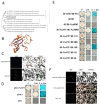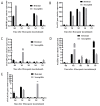Transcription Factor Pso9TF Assists Xinjiang Wild Myrobalan Plum (Prunus sogdiana) PsoRPM3 Disease Resistance Protein to Resist Meloidogyne incognita
- PMID: 34451606
- PMCID: PMC8402125
- DOI: 10.3390/plants10081561
Transcription Factor Pso9TF Assists Xinjiang Wild Myrobalan Plum (Prunus sogdiana) PsoRPM3 Disease Resistance Protein to Resist Meloidogyne incognita
Abstract
The root-knot nematode (Meloidogyne incognita) causes huge economic losses in the agricultural industry throughout the world. Control methods against these polyphagous plant endoparasites are sparse, the preferred one being the deployment of plant cultivars or rootstocks bearing resistance genes against Meloidogyne species. Our previous study has cloned one resistance gene, PsoRPM3, from Xinjiang wild myrobalan plum (Prunus sogdiana). However, the function of PsoRPM3 remains elusive. In the present study, we have investigated the regulatory mechanism of PsoRPM3 in plant defense responses to M. incognita. Our results indicate that fewer giant cells were detected in the roots of the PsoRPM3 transgenic tobacco than wild tobacco lines after incubation with M. incognita. Transient transformations of full-length and TN structural domains of PsoRPM3 have induced significant hypersensitive responses (HR), suggesting that TIR domain might be the one which caused HR. Further, yeast two-hybrid results revealed that the full-length and LRR domain of PsoRPM3 could interact with the transcription factor Pso9TF. The addition of Pso9TF increased the ROS levels and induced HR. Thus, our data revealed that the LRR structural domain of PsoRPM3 may be associated with signal transduction. Moreover, we did not find any relative inductions of defense-related genes PsoEDS1, PsoPAD4 and PsoSAG101 in P. sogdiana, which has been incubated with M. incognita. In summary, our work has shown the key functional domain of PsoRPM3 in the regulation of defense responses to M. incognita in P. sogdiana.
Keywords: Meloidogyne incognita; Pso9TF; PsoRPM3; Xinjiang wild myrobalan plum (Prunus sogdiana); hypersensitive response (HR); tobacco.
Conflict of interest statement
We declare that we have no conflict of interact.
Figures





Similar articles
-
Overexpression of PsoRPM3, an NBS-LRR gene isolated from myrobalan plum, confers resistance to Meloidogyne incognita in tobacco.Plant Mol Biol. 2021 Oct;107(3):129-146. doi: 10.1007/s11103-021-01185-1. Epub 2021 Oct 1. Plant Mol Biol. 2021. PMID: 34596818
-
PsoRPM3 Recognises the Meloidogyne incognita Effector MiTSPc to Trigger Defence Response in Prunus sogdiana.Plant Cell Environ. 2025 Jul 29. doi: 10.1111/pce.70086. Online ahead of print. Plant Cell Environ. 2025. PMID: 40734236
-
Characterization of Five Meloidogyne incognita Effectors Associated with PsoRPM3.Int J Mol Sci. 2022 Jan 28;23(3):1498. doi: 10.3390/ijms23031498. Int J Mol Sci. 2022. PMID: 35163425 Free PMC article.
-
Overexpression of the Prunus sogdiana NBS-LRR Subgroup Gene PsoRPM2 Promotes Resistance to the Root-Knot Nematode Meloidogyne incognita in Tobacco.Front Microbiol. 2017 Oct 31;8:2113. doi: 10.3389/fmicb.2017.02113. eCollection 2017. Front Microbiol. 2017. PMID: 29163405 Free PMC article.
-
Resistance to root-knot nematodes Meloidogyne spp. in woody plants.New Phytol. 2016 Jul;211(1):41-56. doi: 10.1111/nph.13933. Epub 2016 Apr 29. New Phytol. 2016. PMID: 27128375 Review.
Cited by
-
The assembly of a Malus sieversii regulatory network reveals gene resistance against Alternaria alternata f. sp. mali when colonized by Trichoderma biofertilizer.J Plant Res. 2025 May;138(3):483-496. doi: 10.1007/s10265-025-01622-y. Epub 2025 Mar 15. J Plant Res. 2025. PMID: 40089645
References
-
- Abd-Elgawad M.M., Askary T.H. Biocontrol agents of phytonematodes. CAB International; Wallingford, UK: 2015. Impact of phytonematodes on agriculture economy; pp. 3–49. - DOI
-
- Patel B., Patel H.J.T.R. Effect of physical, cultural and chemical methods of management on population dynamics of phytonematodes in bidi tobacco nursery. Tob. Res. 1999;25:51–60.
-
- Brennan R.J.B., Glaze-Corcoran S., Wick R., Hashemi M. Biofumigation: An alternative strategy for the control of plant parasitic nematodes. J. Integr. Agric. 2020;19:1680–1690. doi: 10.1016/S2095-3119(19)62817-0. - DOI
-
- Stirling G.R., Wong E., Bhuiyan S. Pasteuria, a bacterial parasite of plant-parasitic nematodes: Its occurrence in Australian sugarcane soils and its role as a biological control agent in naturally-infested soil. Australas. Plant. Pathol. 2017;46:563–569. doi: 10.1007/s13313-017-0522-z. - DOI
Grants and funding
LinkOut - more resources
Full Text Sources

